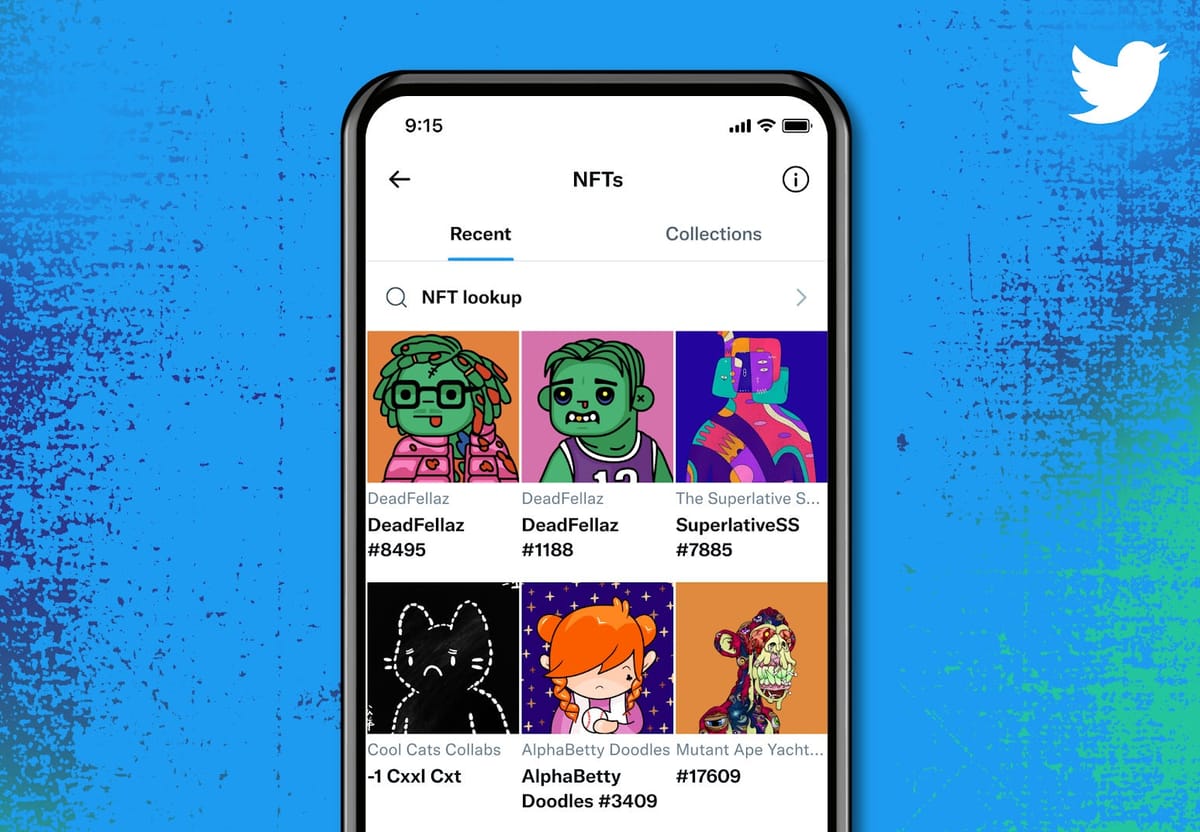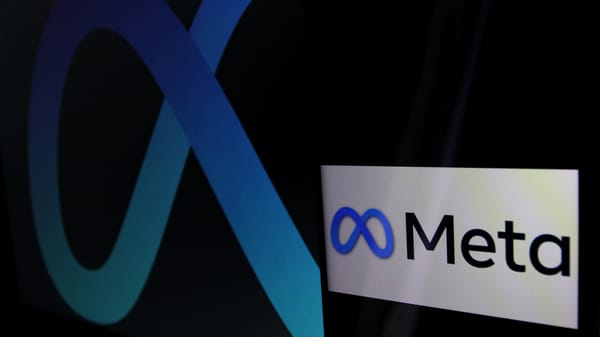The day NFTs went mainstream
The crypto vs. normie war is live on Twitter. Are you a circle or a hexagon?

Today, just four months after announcing it was exploring the idea, Twitter began letting some people use non-fungible tokens as their profile pictures. Subscribers to the $2.99-a-month Twitter Blue service can now connect a crypto wallet to their profiles, and display any NFTs they own in their profile. These users are easily distinguished from those yet to be crypto-pilled by the shape of their avatars: a hexagon, rather than the traditional circle.
In September, when Twitter first broached the idea, I suggested that the company’s adoption of NFTs could take the technology mainstream. Twitter users already invented the hashtag, the @ mention, and the retweet; by using profile pictures to display their (unauthenticated) NFTs already, I argued, owners of CryptoPunks, Bored Apes and other popular collections had invented the NFT profile. And now here it is, as an official Twitter product.
In accordance with the polarizing nature of blockchain-based projects in general, Twitter’s introduction of NFT profiles was met with significant disdain. Recent criticism of NFTs has highlighted the degree to which the technology does not live up to its own promises: of decentralizing power, or even of verifying ownership. (For the most part, NFTs today do not encode the owned media on the blockchain; rather, what is encoded is essentially a receipt for it.) Viewed through this lens, Twitter could be accused of legitimizing a technology that can leave people open to theft, scams, and other dangers.
At the same time, millions of people are about to begin seeing those hexagons every day and wonder what the fuss is about. The question is whether Twitter — and all the other platforms racing to build NFT integrations — can brute-force digital collectibles into popularity, over the strident objections of critics.
As it so happens, we’ve had an early test of that question in the gaming industry. Over the past several months, several top developers have announced plans to integrate NFTs into their games, in the form of digital goods. The resulting stories all generally include the phrase “massive backlash.”
Gamers’ complaints are straightforward. The gaming industry has gradually shifted from a model of charging you a one-time fee to own a game to one in which you might be asked to pay for it multiple times (to download new expansions, or buy cosmetic items); or continuously (via subscriptions). Loot boxes, which award players items at random, introduced an expensive and much-hated form of pseudo-gambling into the gaming world. As a result, gamers often feel nickel-and-dimed by developers, and feel as if the games generally aren’t more fun as a result.
The idea that playing a video game in the future might involve connecting a crypto wallet, paying steep fees just to transact on the marketplace, purchasing scarce digital goods, and then working protect them from thieves — well, it’s not clear how that would make games much more fun, either. (One of my favorite YouTubers, the game critic SkillUp, now has a recurring feature about NFTs in his weekly round-up of games news: it’s called “No Fucking Thanks.”)
And so Ubisoft was roasted after announcing a plan to put NFTs into its shooter game Ghost Recon Breakpoint. Square Enix, makers of the Final Fantasy series and others, drew criticism for suggesting that it could “potentially” offer crypto tokens in the future. Mobile gaming company Zynga seems to have avoided much backlash for hiring a blockchain chief, but then Zynga games have been built on asking players to make constant, frustrating transactions from the start.
For would-be operators of thriving NFT trading platforms, this backlash represents more than a series of negative public relations cycles. Silicon Valley’s collective vision of the next version of the internet, the one we have taken to calling the metaverse, hinges on video games as the thing that will lure the masses to buy augmented and virtual reality headsets. The basic idea, as Mark Zuckerberg articulated to me last summer, is that you’ll buy virtual clothes or other digital goods as NFTs, and take them from VR experience to VR experience, starting with games.
If players continue to hate the idea of NFTs forever, then, the metaverse will look very, very different. And developers that have raised funds at sky-high valuations based on the idea that games will bring billions of people onto web3, such as the team behind Axie Infinity, will suffer.
It’s not just players who are skeptical. In a survey published today by the Game Developers Conference, 70 percent of studios said they have “no interest” in NFTs. Here’s Jay Peters at The Verge:
“When asked how they felt about the possibility of cryptocurrency or NFTs in games, a few called it ‘the future of gaming,’” the survey said. “However, a vast majority of respondents spoke out against both practices — noting their potential for scams, overall monetization concerns, and the environmental impact.”
Many quotes directly from developers were scathing. “How this hasn’t been identified as a pyramid scheme is beyond me,” one wrote. “I’d rather not endorse burning a rainforest down to confirm someone ‘owns’ a jpeg,” said another. “Burn ‘em to the ground. Ban everyone involved in them. I work at an NFT company currently and am quitting to get away from it,” said another.
Of course, another way of reading this data is that almost one-third of game developers today say they are at least interested in NFT integrations. But for now, at least, they are in the minority.
All of which brings us back to the question of how these dynamics will play out on Twitter. There are some important differences between games and tweets: gamers hate NFTs in large part because they feel they fear they will be forced to buy them; on Twitter, buying and displaying any digital art that you purchase will optional. And while the audience for video games numbers in the billions, and defies easy categorization, I imagine Twitter’s diverse audience may have an even wider range of reactions to NFTs in the timeline.
Today I saw reactions of two kinds: from crypto skeptics, dunking on hexagons; and, from crypto enthusiasts, dunking on people who are mad at hexagons.
Who will prevail?
Sometimes, a technology is so reviled from the start that it is driven out of polite society. Ask anyone who wore Google Glass into a bar in 2013 how that worked out.
Other times, though — and this feels especially true on Twitter — things get ridiculed into legitimate popularity. (People who research extremism have a term for the way jokes are often used to smuggle ideas into the mainstream: irony poisoning.) And crypto enthusiasts have been masterful at co-opting insults hurled at them into badges of honor. When critics derided their art works as “JPEGs,” for example, the community quickly began using that term — with a wink — to refer to their collections.
If Twitter can’t take NFTs mainstream alone, it won’t be the last to try. The Financial Times reported on Thursday that Meta plans to let people create and sell NFTs on its platforms. Google now officially has a blockchain team as well, and surely YouTube will fit into its plans.
It’s far too soon to gauge the prospects of any of these efforts, which remain in their earliest stages. But in the meantime, we may look back on Twitter’s hexagon launch as the day NFTs became accessible to a broad, mainstream audience.
Now we wait to see whether the mainstream actually wants them.
Elsewhere on the blockchain: OpenSea had an outage that prevented anyone from seeing their NFTs. Congress held a hearing on the crypto’s carbon footprint. Here’s a “proof of attendance protocol” to mint shared memories as NFTs. And Russia proposed a ban on mining or using cryptocurrencies.
Platformer Jobs
Today’s featured jobs on the Platformer Jobs board include:
- Outreach & Engagement Manager, Digital Trust & Safety Partnership.
- Project Lead, Global Coalition For Digital Safety, World Economic Forum.
- Director, Product, DuckDuckGo.
Some posts here are paid. For more great jobs in tech policy and trust and safety, or to create a listing, visit here. Nonprofits and academic institutions can post for free using the code NONPROFIT.
Governing
⭐ A bipartisan group in the Senate voted to advance The American Innovation and Choice Online Act. I wrote about the implications here Wednesday. Here’s Lauren Feiner at CNBC:
The American Innovation and Choice Online Act passed in a bipartisan manner, setting it on a path to potentially be adopted by the full Senate. All six no votes came from Republicans, though five Republicans voted alongside Democrats to advance the bill out of the committee: Judiciary Committee Ranking Member Chuck Grassley, R-Iowa, who led the bill alongside antitrust subcommittee Chair Amy Klobuchar, D-Minn., and Sens. Lindsey Graham, R-S.C., Ted Cruz, R-Texas, Josh Hawley, R-Mo. and John Kennedy, R-La.
The committee’s House counterpart already advanced a similar bill and its movement in the Senate could bring momentum to that bill as well. While the White House has not yet weighed in on whether it will support this particular legislation, it has generally supported efforts to increase competition and President Joe Biden has installed progressive leaders at the antitrust agencies.
But: Is time running out to pass legislation before the midterms? Big Tech bills are seen as a lower priority than “voting rights legislation, correcting labor and supply chain constraints, enacting a social services package and steering the nation out of the COVID-19 pandemic.” (Cecilia Kang and David McCabe / Washington Post)
How Microsoft earned lawmakers’ trust in antitrust battles. “The company’s decision to push forward with the Activision deal, on the day federal antitrust enforcers announced a review of merger laws designed to address competition in tech, is both a statement of Microsoft’s security in D.C., and a test of that long-running political goodwill.” (Cat Zakrzewski / Washington Post)
⭐ European Parliament advanced a bill that would prohibit advertising based on religious beliefs, sexual orientation, and race and ethnicity. It’s in the latest version of the Digital Services Act. (Clothilde Goujard / Politico)
A French appeals court ruled that Twitter will have to share detailed information about its content moderation practices. It ruled that “Twitter had to provide very incremental data about how it polices material online, including the number, location, nationality and language of the people in charge of processing French content flagged from the platform.” (Laura Kayali / Politico)
Pro-Trump activists are having trouble growing their followings on alt-platforms. An analysis of 47 prominent right-wing influencers across Gab, Gettr, Rumble and Telegram found that their audiences barely grew in the past year, and in some cases declined. (Jeremy B. Merrill and Drew Harwell / Washington Post)
Apple countersued Ericsson in a patent dispute. After a cross-licensing deal collapsed, Apple is now seeking an import ban on Ericsson products. (Florian Mueller / Foss Patents)
Activists are pushing Meta to release the results of a human rights assessment it conducted of the company’s work in India. A draft was submitted to the company in mid-2021 but has yet to see the light of day. (Niha Masih / Washington Post)
A look at the relationship between House Minority Leader Kevin McCarthy and Big Tech. The California Republican talks a big game about reining in tech, but behind the scenes is more measured and even a champion for platforms, people who have worked with him say. (Emily Birnbaum and Haley Fuchs / Politico)
Industry
⭐ Workers in Google’s site reliability group say an abusive culture left them depressed and even suicidal. The company has acknowledged internally that it needs to improve the working environment. Here’s Nico Grant at Bloomberg:
They say managers, including the team’s leader Pierre Aubert, fostered a work culture where discrimination and termination threats were tolerated, if not encouraged. Several members of the 100-person group, they say, took leaves to preserve their well-being. An internal “Googlegeist” survey that tracks employee sentiment found in January 2021 that just 49% of the 76 Borg team members who responded had a favorable view of what their work group was doing to help their well-being, 12 percentage points lower than employees companywide, according to documents reviewed by Bloomberg.
In November, “team temperature” surveys found dissatisfaction among Borg employees. Out of a top score of 10, Borg’s three sub-teams scored 5.07, 6.5 and 6.73—all short of the 7.5 rating Google considers satisfactory. In meetings with human-resources officials, some Borg employees described a toxic and overwhelming work environment, according to notes HR shared with the team that were reviewed by Bloomberg, but Google left the management team in place and promoted Aubert.
And: DeepMind co-founder and Google executive Mustafa Suleyman left after an investigation found complaints about his management style. He’s joining Greylock Partners. (Hugh Langley and Martin Coulter / Insider)
TikTok’s marketing chief was apparently fired for trying too hard. Set aside the breathless tone of coverage here; Nick Tran’s ideas were well within the 2022 mainstream. I imagine he’ll have a new job by tomorrow at the latest. (Lydia Moynihan / New York Post)
Amazon Style, a physical clothing store, is coming to Los Angeles. In the fitting rooms, a “screen allows shoppers to ‘continue to shop a seemingly endless closet of great styles’ without leaving.” (Kurt Schlosser / GeekWire)
Messenger Kids added games to teach internet etiquette and safety practices to children. They also teach kids how to use Messenger. (Kim Lyons / Messenger)
Google began testing Google Play Games for PC, letting people play Android games on Windows machines. The test is currently limited to Hong Kong, South Korea, or Taiwan. (Ryne Hager / Android Police)
Apple has a new head of PR. Longtime employee Kristin Huguet replaces Stella Low. (John Paczkowski / BuzzFeed)
Those good tweets
jpeg is french for "i'm pegging"
— Daisy Alioto (@daisandconfused) 2:24 PM ∙ Jan 19, 2022
a dating app called unhinged and its just people from twitter
— Gilad Rom (🐶,👾) (@giladrom) 10:41 PM ∙ Jan 16, 2022
Yeh you could say I'm a gamer
— Dr. Horace Hungryman, PhD (Official) (@BirdRespecter) 5:32 PM ∙ Jan 17, 2022
pearl with a girl earring
— Dan (@dannah__montana) 5:48 AM ∙ Jan 18, 2022
Talk to me
Send me tips, comments, questions, and your NFT PFP: casey@platformer.news.





